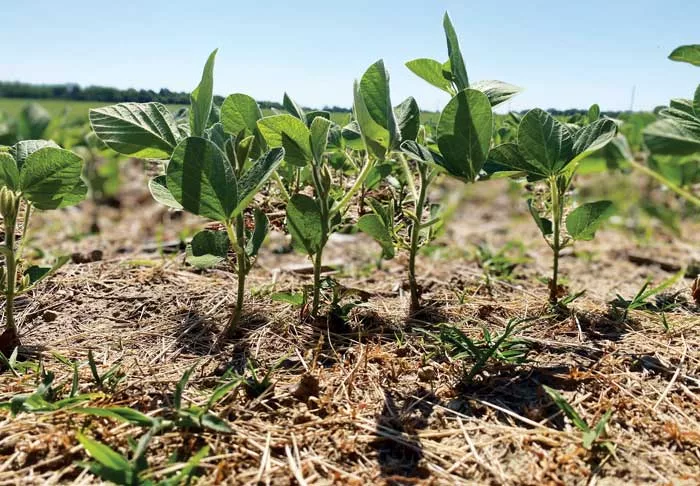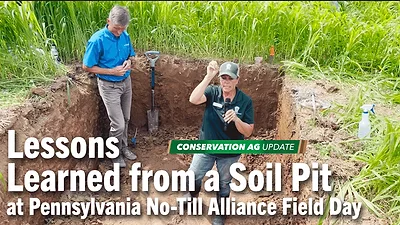A sign that reads “Ohio Bicentennial Farm” stands outside Kris and Lacie Green’s house, honoring the family’s legacy in the village of Wakeman. Kris Green’s ancestors founded the operation known as Willow Brook Farm in 1817 after moving from Connecticut. The family business is still going strong with Green and his dad, Ken, running the 2,000-acre operation about 45 miles southwest of Cleveland.
The Greens started no-tilling soybeans almost 25 years ago but continued to conventionally till corn up until 2019 when Kris fully transitioned to strip-till with corn. The conservation practices are helping to solve their two biggest challenges — soil erosion and labor shortages.
“With heavier rain falling in shorter amounts of time becoming more frequent, soil erosion is a major problem in our area,” Green says. “Labor has been the biggest issue. We just don’t have the workforce anymore. We have one full-time employee. Cutting down on passes has made a huge difference.”
Cover Crop Adoption
Looking for another way to build soil health and reduce inputs, the 7th generation farmer became interested in cover crops. His light bulb moment came in 2016 at a local field day hosted by longtime northeast Ohio no-tiller Dale Daniels.
“They performed a rain simulator test, and I had never seen one of those before,” Green says. “There were two soil samples — one from Dale’s no-till and cover crop farm and the other from a neighbor’s conventionally tilled farm. It really opened my eyes when I saw how much water ran off the neighbor’s sample and how little ran off Dale’s.”
Green was immediately sold.
“I jumped in with both feet and bought a cover crop seeder that mounted on my Apache sprayer,” he says.
“I was listening to a podcast and heard someone say, ‘treat your cover crop like a cash crop.’ That really stuck with me. My dad is supportive of cover crops to an extent, but he probably thinks I’m crazy sometimes.”
Green usually seeds cereal rye in the fall ahead of soybeans at a rate of 55-70 pounds per acre in 15-inch rows with his 30-foot Kinze 3650 planter. Rye has lived up to the hype, Green says, but other species haven’t delivered the same return on investment.
“Treat your cover crop like a cash crop’ — that really stuck with me…”
“Oats and radishes are fine, but they freeze out,” Green says. “We need cover crops that overwinter and provide the erosion protection we’re looking for.
“We tried rapeseed last fall. I wasn’t super impressed. The stand wasn’t what I wanted, and honestly it was hard to kill in the spring. Our herbicide wasn’t touching it. There was still rapeseed trying to flower in mid-June when corn was knee high.”
Green will be the first to admit he doesn’t have all the answers yet when it comes to cover cropping. One of his biggest challenges is figuring out how to seed covers in standing corn.
“By the time we get corn off, it’s usually a little late to put a cover crop on, especially for erosion control,” he says. “Yes, it’s there in the spring, but it didn’t really help us out over the winter. We’re looking at different ways to solve the puzzle. One of our local dealers tried applying cover crops in between rows while sidedressing — that’s something I’d like to look at.”
No-Tilling the Green Way
Cereal rye has paid off the most in the weed suppression department for Green. He interseeds soybeans into standing rye with his Kinze planter and sometimes holds off on herbicide applications for up to 2 weeks.
Green’s biggest no-till truth is, “be patient before planting to make sure the ground is ready.” He’d like to plant in early April every year, but if conditions aren’t right, he’s not scared to wait until June to get started.
Shooting for soybean yields around 60 bushels per acre, Green takes a unique approach to seeding rates. He’s trying rates as low as 70,000 on his best ground and as high as 140,000 in other areas.
“We seeded at a rate of 90,000 on a few check blocks one year,” Green says. “That probably sounds pretty crazy to some people. But the 90,000 check block actually outyielded the 140,000 outside of the check block. We realized we could continue to drop our rates comfortably on our best ground.”
Green applies phosphorous (P) and potassium (K) to soybeans at variable rates, determined by soil testing results. A local co-op sends a file to his iPad that shows where they need to pull soil samples. Lacie and the kids, Hazel, Ezra and Haddie, drive an ATV out to the recommended spots, collect the samples and sends them off for testing.
“With fertilizer prices as high as they are, we’re not putting any more on than we have to,” Green says. “We’re only 12 miles away from Lake Erie so we’re also trying to be conscientious of water quality, and we don’t want to see our dollars flow off into the lake.”
From Conventional to Strip-Till
Unlike his entry into cover cropping, Green didn’t jump into strip-till with both feet. A field representative at his local soil health partnership encouraged him to give it a try in 2016.
“I rented a Hiniker 12-row strip-till unit from our Case IH dealer,” he says. “We strip-tilled 42 acres in a couple fields. When we harvested there wasn’t a huge difference in yield — if anything there was a slight bump.”
Green increased his strip-till acreage to 100 acres the following year. He was pleased enough with the results that he bought the unit and now strip-tills 100% of his corn acres.
Green builds strips in the fall and applies monoammonium phosphate (MAP) at variable rates determined by soil test results.
“The rates depend on the needs of the soil,” Green says. “Some areas get nothing, and some get up to 150 pounds per acre.
“We use a shank machine in the fall to build strips. If we strip-tilled in the spring, it would likely be a disaster because our topsoil is about 8 inches thick.”
He seeds corn in 30-inch rows at rates ranging from 32,000-36,000 with 30 pounds per acre of nitrogen (N) at planting, followed by a split N sidedress application of 130 pounds knifed in with a 28% applicator at V3, and another 40 pounds around V10 with his sprayer.
If available, he’ll utilize chicken manure from a neighboring farm, sometimes spreading 1.5 tons per acre where needed.
Always looking to upgrade his equipment, Green ordered a new corn planter in 2023 — a Case IH 2150 with a precision planting package, including hydraulic downforce and SpeedTubes.
“With the hydraulic downforce and SpeedTubes, we can travel faster, have good spacing and make sure our depth is consistent,” he says.
Although his average corn yields are between 180-190 bushels per acre, he’s reached as high as 260 on his best ground. “That kind of number is pretty uncommon for this area of the country,” Green says.
On top of boosting yields, Green has also noticed his switch to strip-till, combined with no-till and cover crops, has significantly improved the soil health at Willow Brook Farm.
“I’m seeing more earthworms, which is very encouraging,” he says. “They’re doing a lot of work for us. More tillage equals more harm. The less we can disturb the soil, the better off we are.”







